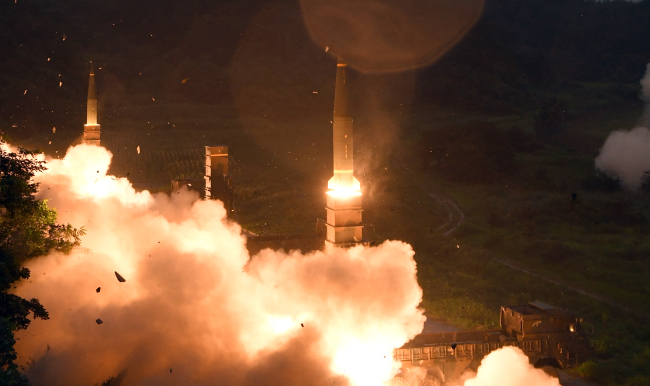South Korea's military said Monday it conducted a combined live-fire exercise in response to North Korea's sixth nuclear test a day earlier.
The training aimed at improving the capability of striking the North's Pyunggye-ri nuclear test site involved the Hyunmoo ballistic missile system and F-15K fighter jets.
In the drill, the Army's Hyunmoo-2A surface-to-surface missile and the F-15K's SLAM-ER precision-guided air-to-ground rocket accurately hit a designated target in the East Sea, according to the Joint Chiefs of Staff.
It said the range to the simulated target was set in consideration of the North's Punggye-ri nuclear test site in its northeastern province.

The JCS did not specify the venue for Monday's training. For instance, defense officials said, the North's Punggye-ri area is located some 280 kilometers far away from Sokcho, a city in South Korea's Gangwon Province.
The Hyunmoo-2A's range is around 300 km, and the SLAM-ER can fly up to 270 km.
"The training demonstrates the South Korean military's resolve to destroy not only the origin of provocation but also the enemy's leadership and supporting forces if they threaten the security of our people," Army Col. Roh Jae-cheon, the JCS spokesman, told reporters.
He added, "We staged the real-distance shooting exercise, simulating the Punggye-ri area as the origin of provocation."
The Ministry of National Defense, meanwhile, said it's preparing for joint measures with the US military for a show of force against the North's provocation.
"South Korea and the US are in consultations on appropriate ways on the issue," the ministry's spokesman Moon Sang-gyun said at a press briefing.
On the scale of the North's latest nuclear test, Moon reaffirmed Seoul's assessment putting the magnitude of the artificial earthquake at 5.7, which means the explosive yield of around 50 kilotons.
"Our evaluation is based on objective data," he stressed, citing the criteria set by related international agencies, such as the Comprehensive Test Ban Treaty Organization.
Some foreign think tanks said the North's nuclear test caused up to a 6.3 magnitude quake, which produced a destructive power likely in excess of 100 kilotons.
Meanwhile, South Korea is seeking to double the maximum payload of its ballistic missiles. Under a bilateral accord with the US revised in 2012, it can develop ballistic missiles with a range of up to 800 km and a payload weight of up to 500 kg.
In their recent phone talks, the South's President Moon Jae-in and US President Donald Trump agreed "in principle" to revise the so-called missile guidelines. (Yonhap)







![[Graphic News] More Koreans say they plan long-distance trips this year](http://res.heraldm.com/phpwas/restmb_idxmake.php?idx=644&simg=/content/image/2024/04/17/20240417050828_0.gif&u=)
![[KH Explains] Hyundai's full hybrid edge to pay off amid slow transition to pure EVs](http://res.heraldm.com/phpwas/restmb_idxmake.php?idx=644&simg=/content/image/2024/04/18/20240418050645_0.jpg&u=20240419100350)








![[KH Explains] Hyundai's full hybrid edge to pay off amid slow transition to pure EVs](http://res.heraldm.com/phpwas/restmb_idxmake.php?idx=652&simg=/content/image/2024/04/18/20240418050645_0.jpg&u=20240419100350)

![[Today’s K-pop] Illit drops debut single remix](http://res.heraldm.com/phpwas/restmb_idxmake.php?idx=642&simg=/content/image/2024/04/19/20240419050612_0.jpg&u=)